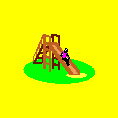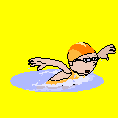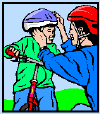|
Don't Swim With Shocks - CPSC, American
Red Cross Warn of Electrocutions in Swimming Pools, Hot Tubs and Spas
WASHINGTON, D.C. - As the weather warms up, swimmers across the
country are heading out to backyard, community and public pools, hot tubs
and spas. When it comes to pool safety, drowning is the first concern
that comes to mind; but today, the U.S. Consumer Product Safety Commission (CPSC)
and the American Red Cross are warning of another hidden danger to swimmers:
electrocution. There have been 60 deaths and nearly 50 serious shocks
reported over the past 13 years involving electrical hazards in and around
swimming pools.
The CPSC is most concerned about faulty underwater lighting; aging
electrical wiring that hasn't been inspected in years; the use of sump
pumps, power washers, and vacuums that are not grounded; and electrical
appliances (such as radios and TVs) and extension cords falling or being
pulled into the water. All of these hazards present an even greater
risk if the lighting, circuits, and nearby receptacles are not protected by
Ground-Fault Circuit-Interrupters (GFCIs) - the best safety device to
prevent electrocution.
"The best protection for families is inspection, detection, and
correction of electrical hazards in and around swimming pools, hot tubs and
spas," says CPSC Chairman Hal Stratton. "CPSC strongly
encourages residential and commercial pool owners and operators to upgrade
protection of the lights, receptacles, and switches with GFCIs. Older
pools are the biggest concern, as underwater lighting fixtures may have
degraded with age and may not be protected by GFCIs."
The CPSC and the American Red Cross are also warning
swimmers that electrical hazards around a pool, hot tub or spa can lead to
multiple deaths or injuries. This occurs when an individual becomes
incapacitated by stray current in the water and one or more persons jump in
or reach out to save the victim, resulting in multiple electrocutions or
serious shocks.
In May 2002, a 14-year-old girl from Arlington, Texas, was
electrocuted when wiring problems in an apartment swimming pool's underwater
lights charged the water with electricity. A 16-year-old boy was
seriously shocked when he jumped in the pool to try to save the young girl.
Another teenager used a fiberglass shepherd's hook (a non-conductive device)
to pull both victims from the water.
Parents and pool owners should have an emergency plan, posted in the pool
area, to safely help someone who is suffering an electrical shock.
This action is necessary to prevent the victim from drowning and to protect
others from the harm of electrical energy in or around the pool.
In an emergency, the American Red Cross recommends turning off all power;
using a fiberglass hook to carefully remove the victim(s) from the water;
administering CPR; and calling 911.
For more information about electrical safety around pools, hot tubs or spas,
consumers should contact CPSC at (800) 638-2772 or www.cpsc.gov.
Consumers also can download our publications, "Don't
Swim With Shocks - Electrical Safety In and Around Pools, Hot Tubs and
Spas," and "Install Ground-Fault Circuit Interrupter Protection
for Pools, Spas and Hot Tubs."
CPSC's Safety Tips For Preventing Electrocutions In and Around the Pool:
-
Know where all the electrical switches and circuit
breakers for pool equipment and lights are located and how to turn them
off in an emergency.
-
Refrain from swimming before, during, or after
thunderstorms.
-
Have an electrician who is qualified in pool and spa
repairs inspect and upgrade your pool, spa or hot tub in accordance with
applicable local codes and the National Electrical Code (NEC).
-
Ensure that all electrical wires and junction boxes are
at least five feet away from water, as required by the NEC.
-
Protect swimmers from injury by following the NEC
requirements for installing GFCIs: - on underwater lighting
circuits operating at 120-volts (CPSC recommends GFCIs for
circuits that are 15 volts or greater); - on pumps and electrical
equipment used with pools, spas and hot tubs, including
heaters close to the pool and operated on 240 volt circuits; - on
electrical circuits around pools, spas, and hot tubs; - on all
outdoor receptacles and receptacles within 20 feet of the water's edge
to protect people from injury.
-
Test GFCIs monthly to assure continued protection.
Infrequently used and portable or cord-connected GFCIs should be tested
before each day's use. To test a GFCI: - Plug a nightlight
into the outlet and turn the nightlight on. Press the
"TEST" button. Did the light go out? If not, replace the
GFCI or have it inspected by an electrician. Press the
"RESET" button. Did the light come back on? If not,
replace the GFCI. Wear shoes while conducting the test, especially
if outdoors or standing on wet ground.
-
Use battery-operated appliances instead of
cord-connected appliances in and around a pool, spa, or hot tub.
-
Post an emergency plan within clear view of those using
the pool.
-
Ensure that overhead power lines and junction boxes are
safely positioned when installing a new pool, hot tub or spa.
|
For More Summer Safety Tips go to
CPSC Warns about Pool Hazards, Reports
250 Deaths of Young Children Annually - Federal Agency Launches
Drowning Prevention Initiative, Holding Public Hearings
CPSC, Industry & Safety Groups Mark Baby
Safety Month with Drowning Prevention Campaign
Safety News - Summer Safety Warning - Press Release from Consumer Product Safety Commission
Pools and Parasites- Keeping Your Child Safe - The Children's Digestive Health and Nutrition Foundation (CDHNF) Warns Parents about Dangerous Waterborne Bacteria and Parasites Peak During Late Summer

For Summer Travel Tips to to
Tips for Making the Most of Summer
See the following sections for other travel news
about safety:
Safety News - Summer Safety Warning - Press Release from Consumer Product Safety Commission
First Aid Safety Tips for Managing an
Emergency Click Below:

For Playground Safety News Click
Below:

For Balloon Safety Click Below:

For Beach/Pool Safety News Click
Below:

For Crayon Safety Click Below:

For Car Safety News Click Below:

For Bike and Bike Helmet Safety News
Click Below:

For Crib Safety News Click Below:

For Airplane Safety Click Below:

For Helmets for Skiers and
Snowboarders, Click Below:

For Skiing Safety Click Below:

For Safety News for Children's Clothing Click Below:

For Scooter Safety News Click Below:

Back to
Travel Safety News
|